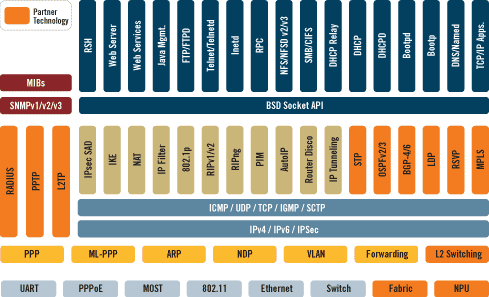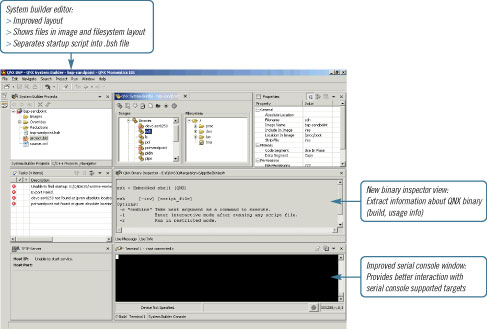QNX Community Resources
Product Preview: QNX Momentics v6.3
QNX® Momentics® development suite Professional Edition (PE) v6.3 offers a number of new features and enhancements — all designed to accelerate the delivery of high-quality, future-ready products. Featuring the QNX Neutrino® realtime OS (RTOS) v6.3, the suite supports new advanced graphics and display capabilities, including 3D and a new HTML 4 embedded browser, GCC 3.3.1 compiler and code coverage tool, added support for security and advanced networking protocols, and ongoing enhancements in reliability and performance.
View the datasheet (110K, PDF).
QNX Neutrino v6.3
Performance and Reliability Optimizations
- POSIX message queues
- New asynchronous implementation enhances message queue performance
- In-processor performance counters
- Enable extraction of fine-grained CPU metrics to improve overall processing performance. Includes support for PowerPC 7450, BCM1250, Pentium II/III/IV and Xeon
- Resilient flash file system architecture
- Designed to maintain integrity in the event of power failure
- Enables use of flash for file storage, firmware upgrades, configuration tables, and downloadable software modules
- Extended memory for x86, MIPS, and PowerPC
- Goes beyond 4G to support the processor's full physical addressing capabilities, eg. 36 bit on x86/ppc (64G), and 40+ bits on MIPS (1TB)
- Support for PowerPC Book E family
- IBM 440, Motorola PowerQUICC III (8450, 8560)
- Improved standards conformance
- Support for C and C++ library based on c99 conformance, providing full implementation of the C/C++ standard
- Based on the latest conformance specification
Network Security and Interoperability
- Stream Control Transmission Protocol (SCTP)
- New support for end-to-end, connection-oriented protocol that transports data in independent sequenced streams
- Powerful transport layer is based on Internet Engineering Task Force (IETF) standards
- Delivers the performance, robustness and reliability required for transporting realtime multistreaming applications such as video, voice, and multimedia
- IP Filter and Network Address Translation (NAT)
- New security support for IP Filter and NAT protocols, offering rules-based filtering of IP packets to optimize packet inspection performance and minimize bottlenecks in firewalls, network gateways and switches
- New protocol stack works seamlessly with the existing QNX Neutrino Core IPv4 networking protocol stack or Enhanced Dual IPv4/IPv6 networking protocol stack, to explicitly deny/permit any packet from passing through the gateway, based on filtering rules
- Enhanced IPv4 Protocol Support
- Extends PPP support to include multi-link PPP, on-demand connections, compression, Network Time Protocol (NTP), and a new poll function for interoperability with other UNIX implementations
- Choose from three configurations: Core IPv4 networking stack, Enhanced Dual IPv4/IPv6 networking stack, and Tiny TCP/IP stack
- Transparent Distributed Processing
- Provides unified access to hardware and software resources on remote nodes, using standard messages
- New Global Name Service provides global directory of applications, supporting location independence and flexible deployment of applications such as message queues, filesystems, services, and databases
- Offers optimized processing performance for "in the box" LAN/backplane communications
- Multiple cards can register for the same service, providing optimal use of shared resources
- Framework saves the time and cost associated with custom code development and incremental hardware
Advanced Graphics
- New embedded HTML 4 browser
- QNX Voyager 2, with ACCESS' NetFront technology delivers advanced browser features and Internet standards support for small footprint embedded devices
- Supports advanced small screen rendering capabilities, enterprise-grade security and features a modular architecture for flexible configuration and expansion
- Available in standard and custom profiles
- Supports PowerPC, SH-4, ARM, MIPS, and x86 architectures
- Multi-layering support
- Support to enable 3D and 2D implementaiton on layers
- Based on the Mesa implementation of the Open GL specification (v.1.4), which allows developers to leverage a greater base of OpenGL source code to develop 3D graphics
- 3D graphics
- Delivers improved visualization and differentiation for graphic displays
- Can render directly to window/widget, hardware or layer, reducing memory footprint
- Multi-buffering automates moving between contexts to accelerate animation and design process
- Implements standard mechanism to create composite displays incorporating 2D and 3D
- 3D hardware acceleration on selected chipsets, including Fujitsu Coral-P
- Multi-headed displays
- Enables improved visualization and usability for developers by allowing a single visual to be displayed across multiple monitors simultaneously
- Renders multiple views to multiple monitors simultaneously from a single head unit, eliminating the need for costly dedicated head units per display
- Eliminates cost and development time for custom configurations
- Improved multi-language support
- The QNX Photon microGUI® windowing system supports a standard encoding mechanism (UTF8) for all text, including a facility for translating to or from UTF8, with support for over 20 language variants
- Enables easy adaptation of products for different geographies
- Latest supported language is Chinese based on GB18030, which is mandatory for meeting Chinese import requirements
- New Korean input method joins support for Japanese and Chinese input methods
- The QNX Photon microGUI® windowing system supports a standard encoding mechanism (UTF8) for all text, including a facility for translating to or from UTF8, with support for over 20 language variants
USB 2.0 Host Support
- Mass Storage Class USB Driver
- Using the USB driver development kit, developers can customize the standard class drivers or extend support to include other USB 2 devices from the following classes: HID, printer, and mass storage class
QNX Momentics v6.3
Expanded Tools Support
- GCC 3.3.1 compiler
- Delivers improved compliance with C99 C and C/C++ multi-vendor Application Binary Interface (ABI) standards
- Provides forward migration path for binary C++ applications, and improvements in compiler code generation performance
- Code coverage
- Assures code quality by allowing developers to target areas of highly used code for performance analysis and debugging
- Provides multi-run coverage amalgamation support
- Highlights which source code paths are being exercised
- Based on GNU profiling and code coverage formats used by gcov and gprof tools
- Fully integrated with QNX Momentics IDE
- System builder tool
- Automates the creation of new BSP projects within the QNX Momentics® IDE
- Features improved external tool integration and serial console interaction
- Provides optimal build of embedded Flash and boot images within the Eclipse workspace builder model
- System profiler
- Delivers improved data visualization and interpretation in areas such as CPU activity and event statistics
- Linux development host
- The newest option is added to support for Windows, Solaris, and the QNX Neutrino RTOS v6.3, providing choice and flexibility to embedded developers
- Offers choice of Gnome Toolkit (GTK) or Motif
- IDE Integration with Eclipse v2.1.2
- Upgrade to the newest version and addition of C/C++ Development Tools (CDT) Framework v1.2


